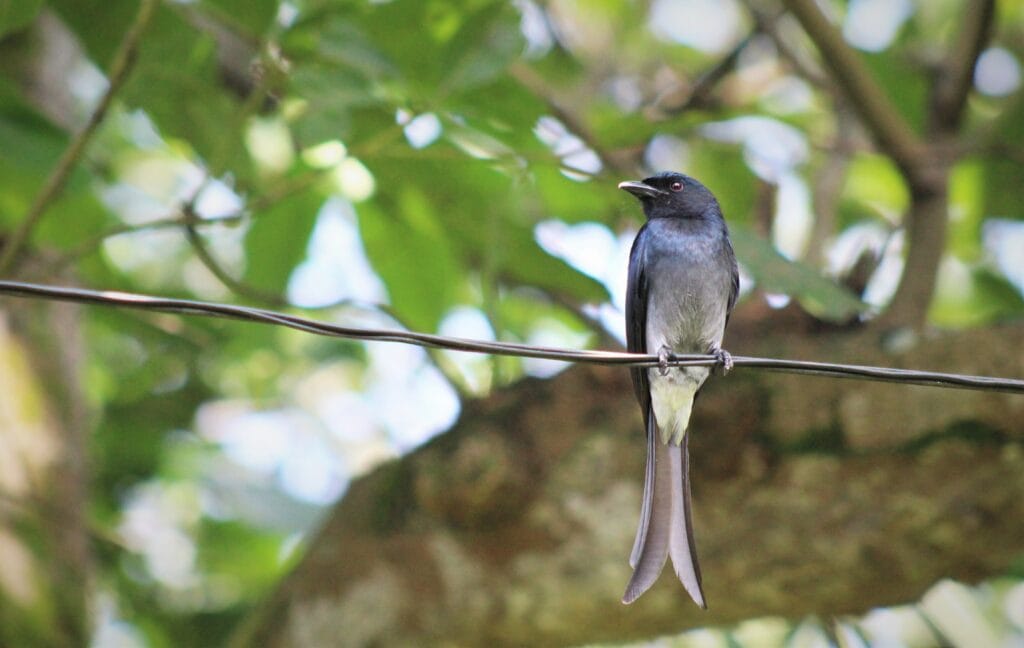Drongo, to many Australians, is a word that means “idiot,” “fool,” or “incompetent.” Ironically, though, this insult derives from a bird whose intellect is not yet entirely understood by science but may eventually redefine the limits of avian intelligence. The drongo family is a family of passerines, or perching birds, which are widespread in Australia, Africa, South and Central Asia, and the Pacific Islands. As one of Asia’s most common birds, the drongo is beloved by many for its clever mimicry, often beautiful voice, and tendency to eat pest insects. (1)
Drongo Symbolism and Meaning
The drongo can be connected with many wonderful traits, but first let’s examine why this bird has become synonymous with stupidity in Australia. As a matter of fact, this insult is not the fault of the drongo at all! In the 1920s an Australian racehorse with an impressive pedigree was given the name “Drongo,” perhaps because of the speed and agility that these birds exhibit. While initially well-performing, Drongo the racehorse was “always the bridesmaid and never the bride.” Over the course of the 1920s, this horse competed in thirty-seven races, often placing or showing but never managing a single win. Was Drongo a terrible horse? Obviously not, but the association of the drongo with failure persists to this day. (2)
Ironically, one of the main features of the drongo bird is intellect. The “theory of mind” refers to the human ability to understand that other beings experience different mental states. Some researchers suggest that drongos may possess this ability on account of a particularly mischievous behavior for which they are known. Drongos are thieves. They are often observed using their impressive repertoire of mimicked sounds and calls to mimic the alarm calls of other animals, causing those animals to abandon their foraged food and allowing the scheming drongo to swoop in and snatch its prize. Drongos in Africa are known to have up to fifty-one different alarm calls at their disposal which they use to prevent their target from catching on to the false alarms. This suggests some understanding of the fact that other animals can acclimate to these alarms as well as an understanding of how and why alarm calls function. Drongos are associated with cleverness, trickery, thievery, empathy, mimicry, and self-awareness. While the drongo name may sound silly, when it comes to intellect, these birds are heavy hitters. (3)
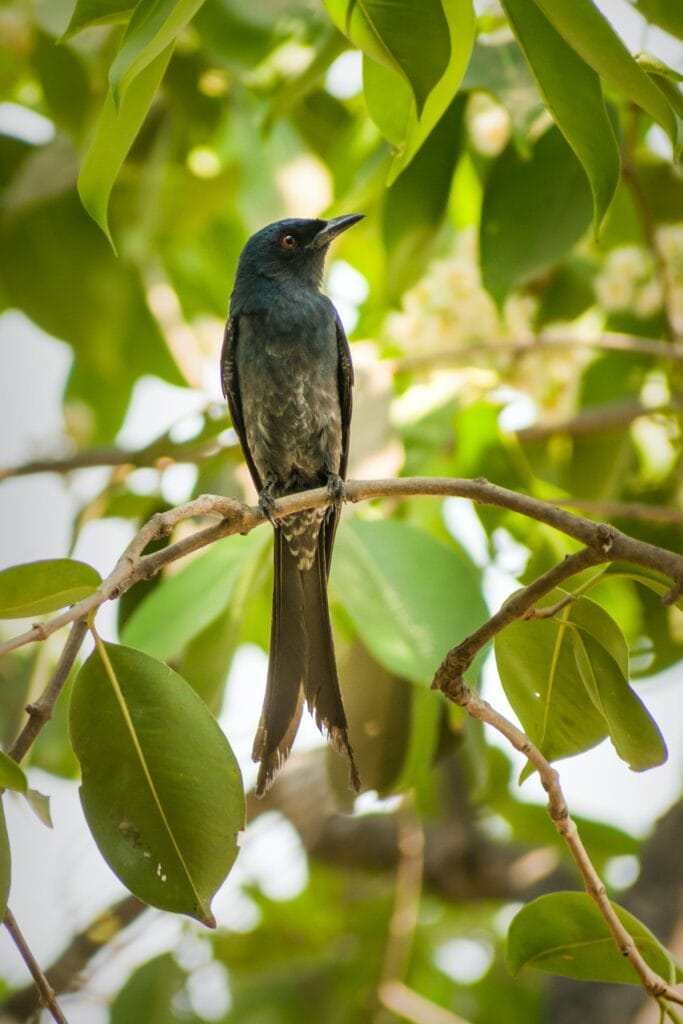
Drongos primarily feed off of insects. This diet has caused the drongo to develop unique relationships with humans based on the context. Beekeepers often treat drongos as pests, since these birds will happily devour bees along with other insects. For farmers, though, drongos are welcome helpers who regulate pest insect populations. Some farmers even provide perches to encourage drongos in their fields. So, the drongo can symbolize the complexity of humanity’s relationship with nature and the symbiotic relationships that can be formed with members of the animal kingdom. (4)
Finally, drongos are known for their pugilistic tendencies when it comes to protecting their nesting territories. Drongos fiercely defend nesting territories against intruders of all kinds. Birds of prey, hungry foxes or jackals, or any other dangerous intruder is sure to be met with a flurry of dives and pecks when venturing too close to a drongo’s nest site. This tendency has led to an interesting pattern wherein more pacifistic birds, such as doves, will often opt to nest near drongos. They benefit from the protectiveness of the drongo. This relationship has inspired the nickname “Kotwal” which5) is Hindi for “police officer,” for drongos in parts of India. Because other birds rely on the drongo’s ferocity, some myths treat the drongo as protector or king of the birds. The drongo represents courage, vigilance, protection, fearlessness, and altruism. (5)
Drongo Native American Symbolism
Drongos are not found in the Americas, so they do not appear in Native American mythic traditions. In many traditions, though, birds who mimic other birds are featured as clever tricksters.
Drongo Christianity Symbolism
While not a biblically significant symbol, the drongo’s tendency to draw in peaceful birds and protect them alongside its own nesting site is reminiscent of the Christian value of the good shepherd who protects and guides the flock of believers.
The drongo’s mimicry and thievery, however, can also connect this bird with dishonesty and criminality.
Drongo Celtic Symbolism
Drongos are not present in the regions where the Celtic cultures developed.
Drongo in Dreams
Dreaming of a drongo may indicate that one feels defensive or anxious. A drongo dream may mean that you feel drawn to protect yourself against outsiders whom you perceive as a threat to all that you have built. Standing up for yourself and others is a great thing, but don’t forget to loosen up once in a while and find a way to trust in others. Not everyone is out to harm you.
Dreaming of a drongo might also indicate that one feels manipulated by others. Like the African drongo species which sound the alarm in order to earn an easy meal, somebody in your life might be manipulating your emotions for their own benefit. Try to maintain level-headed and realistic emotional responses to the situations that arise, and you will be immune to these sorts of schemes.
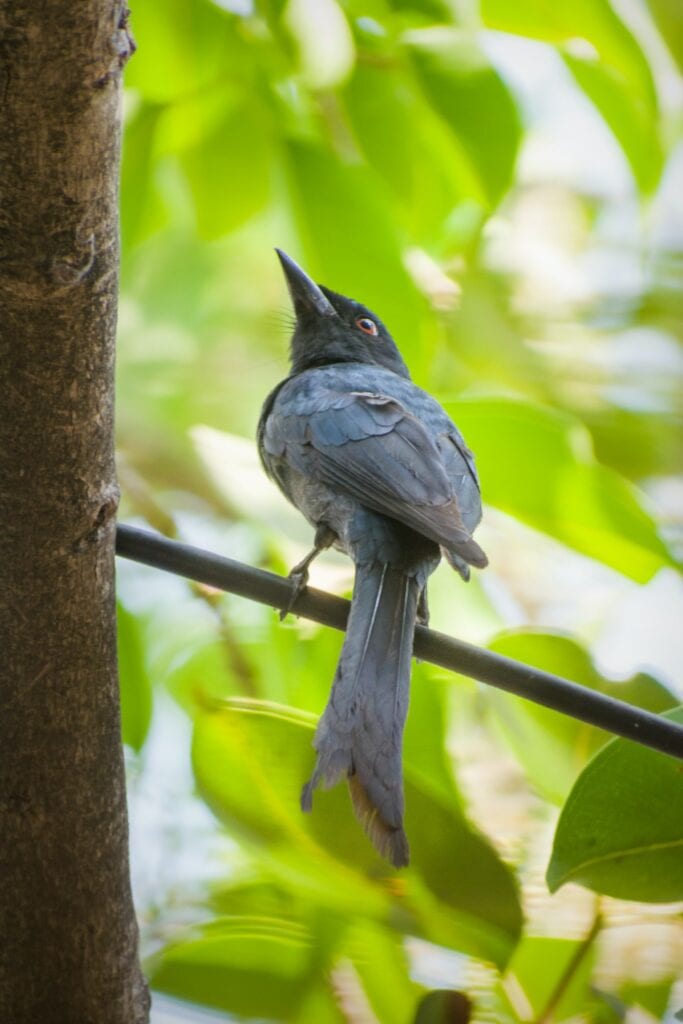
Drongo Encounters and Omens
Encountering a drongo can be a sign to relax and let go of fear. Certain species of drongo spend their days constantly firing off alarm calls and “crying wolf” over nothing. Remember that not every minor crisis is a five alarm fire. Approach situations with as much calm as you can muster and not even the drongo’s mimicry will be able to work you into a frenzy.
Although many drongo birds use their “power” for sneaky purposes, the power to understand the mental and emotional states of others is a pretty impressive one. Encountering a drongo might indicate an opportunity to exercise and grow one’s empathy and emotional intelligence. These skills are helpful in interpersonal relationships and can be important for self-actualization.
Drongo in Mythology & Folklore
Drongos appear in a number of global myths as characters that range from overly confident tricksters to benevolent rulers of the kingdom of birds.
Aboriginal Mythology:
The Spangled Drongo is the hero of one Aborginal “Dreamtime” story. In this story, all of the birds of the world once gathered around the great sleeping Rainbow Serpent. The serpent emitted the warmth and heat of day and the birds were terribly cold. Although the Rainbow Serpent was warm, the birds could not get too close, because he would swat them with his tail. So, one by one, the birds tried to steal Rainbow Serpent’s fire to bring themselves enough warmth to share. They each failed at this task until, desperate, the birds begged the clever Spangled Drongo for a solution. Fearless, Spangled Drongo rushed towards Rainbow Serpent and, before the serpent could wake from his nap, Spangled Drongo stole the wood that fed his flame. As the drongo made his escape, Rainbow Serpent woke up and lashed his tail at the thieving bird. To this day, the Spangled Drongo has a notch in his tail where the serpent lashed it. Thanks to Spangled Drongo’s daring plan, the birds were warm enough to survive. Annoyed by their interference, Rainbow Serpent left his napping place and brought the light and heat of daybreak to the world. (6)
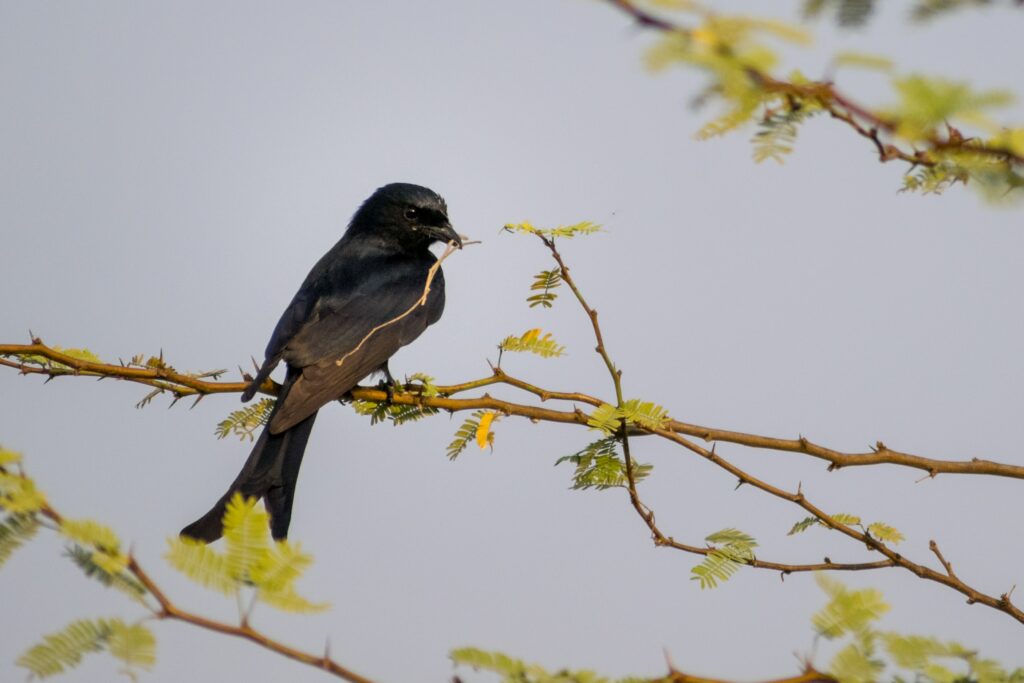
African Mythology:
This myth is purported to have originated in Madagascar, however sources differ on its exact origin and authenticity:
“There was a great fire in God’s kingdom, and He sent all the birds to put it out. However, only the bat was successful—he beat the flame out with his large wings (which is also how he lost his feathers). The drongo, who was pure white, covered himself with ashes and hurried back to God before the bat could get there. He said, “I put out the fire. Look at how black I am.” God was pleased and made him the king of birds. The bat arrived soon after, but God did not believe that he had put out the fire. The bat was understandably angry, and declared that he would forever turn his rear to God. To this day, the drongo is regarded as a clever bird, and the bat remains upside down.” (7)
Indian Mythology:
One Indian legend describes how the Greater Racket-tailed Drongo successfully became the king of birds. According to this story, the drongo was once a much more plain-looking bird with a short tail. Unsatisfied, this drongo wished to be the most handsome bird around. One day, the drongo met a mouse who wished to be the most handsome mammal in the world. The two creatures decided that they could help each other achieve their dreams. To help the drongo, the mouse gave the drongo a long tail just like his own, and plucked extra feathers to cover it. The drongo was delighted, but he soon realized that he could be the most beautiful animal of all with this new tail. When the time came to return the favor and help the mouse, the drongo plucked the hair from the mouse’s tail and flew away, leaving the mouse with an ugly hairless tail. A meeting of all the birds was held, and thanks to his deceptive trick, the drongo was declared the king of birds. Because he fears retaliation from the mouse, the Greater Racket-tailed Drongo likes to sleep at the tops of thorny trees to this day. (8)
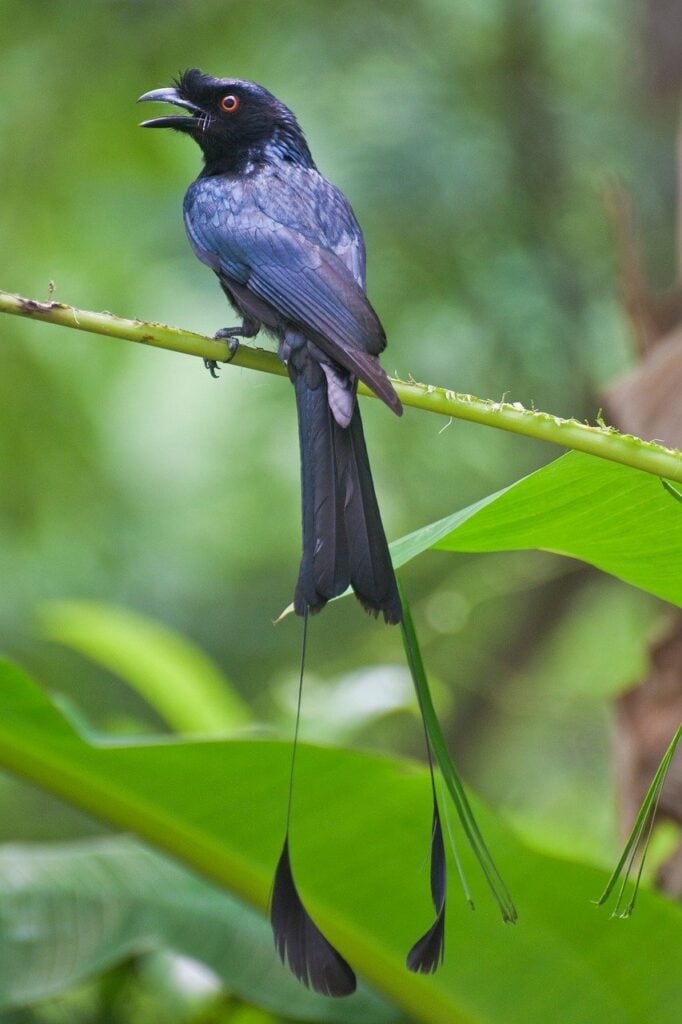
Drongo Spirit Animal
The drongo spirit animal is empathetic, intelligent, playful, and mischievous. People with this spirit animal are fiercely protective of their loved ones, but that doesn’t stop them from pulling pranks on their friends and families. Well-meaning and serious when it counts, the drongo spirit animal will go to great lengths to land a good joke.
People with the drongo as their spirit animal are sociable and welcoming. Not one to stick to their own small group, the drongo spirit animal is happy to befriend all sorts of people and sees every stranger as a potential buddy. The quickest way to befriend the drongo spirit is through shared laughter.
People with the drongo spirit animal may like to goof around, but when a trick goes to far they are the first ones to stand up for their friends. If there’s one thing the drongo spirit cannot put up with its those who pick on the weaknesses of others.
Drongo Totem Animal
The drongo totem animal is connected with awareness. The awareness that other creatures undergo unique mental states does not seem to be a common trait amongst animals. Yet, the drongo is clever enough to both notice and manipulate the mental states of other animals. The drongo totem animal connects us with higher awareness and provides valuable perspective.
When one is struggling to get past one’s own challenges, becoming aware of the unique struggles that every other creature is facing can be a great source of comfort and gratitude. The drongo totem animal uses perspective as a healing tool as well as a way of understanding the self better.
Drongo Power Animal
The drongo power animal is associated with cleverness and problem-solving. The drongo is not only clever enough to trick other animals with its alarm calls, but smart enough to switch up the alarm calls so that the animals in question don’t become wise to its tricks. The drongo power animal represents quick thinking and problem-solving abilities. (9)
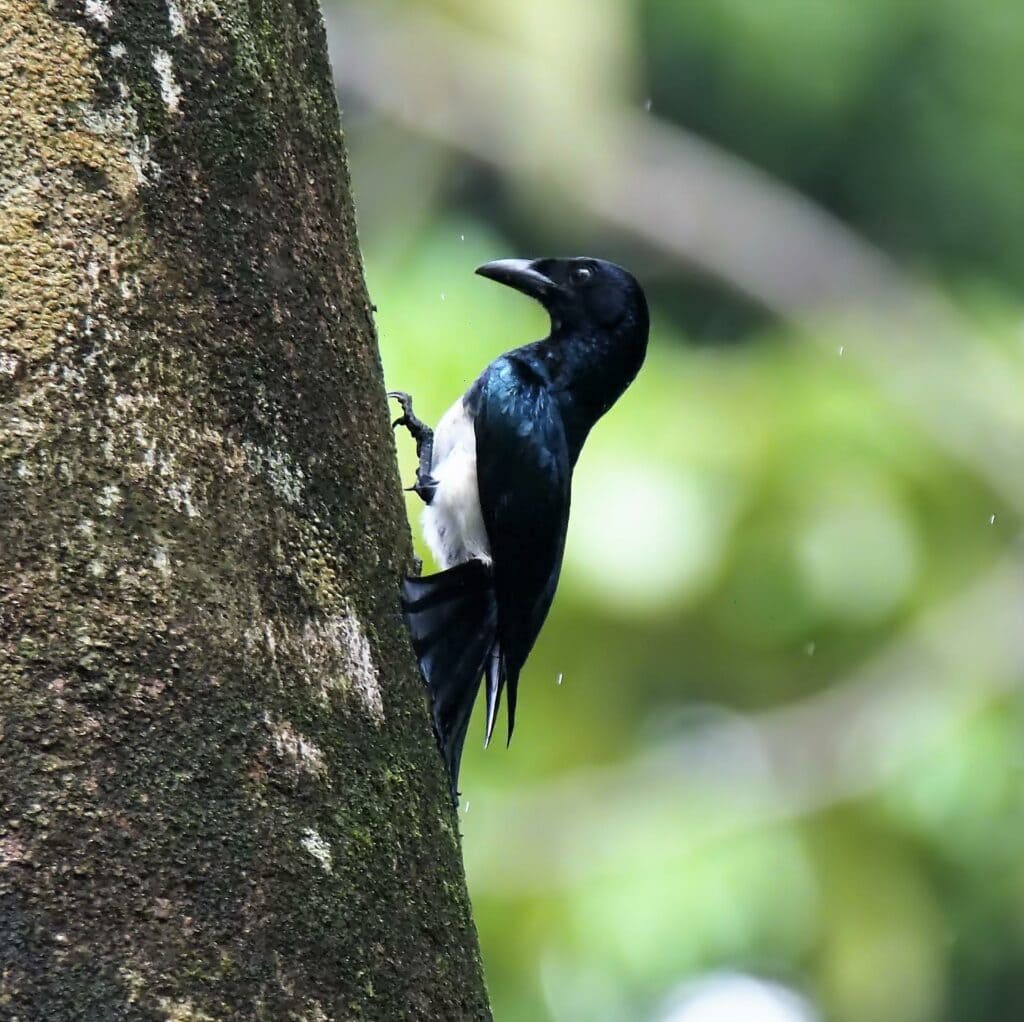
People with the drongo power animal may be drawn to puzzles or may find that they are extra skilled at finding novel ways of approaching issues.
Drongo Tattoo Meaning
A drongo tattoo may symbolize protectiveness and fearlessness. Thanks to the protective drongo, birds like doves can continue to lead peaceful existences within the drongo’s nesting territory, and can rely on the drongo to drive off predators.
A drongo tattoo may also represent mischief, deceit, thievery, or cleverness. The drongo’s tendency to mimic alarm calls and snatch food is one of this bird’s most memorable behaviors.
The drongo is a pretty clever animal, but it does still share its name with the historical racehorse who has become synonymous with incompetence. So, a drongo tattoo may represent silliness, stupidity, or failure. This is mostly true for Australians, where this slang is common.
Conclusion
The drongo might sound goofy, but this bird is much more clever than you might think. Capable of both cutthroat thievery and altruistic protectiveness, the drongo is a complicated animal whose incredible intelligence both helps and harasses the animals with which it shares its habitat. King of the birds or just a lowly trickster, the drongo’s abilities are nevertheless impressive!

